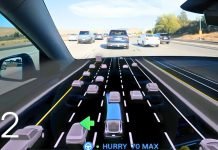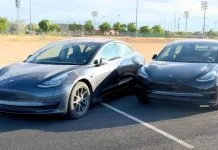When considering the most recent controversies related to autonomous vehicles, there’s a story about a Tesla that reportedly deliberately swerved towards an approaching car rather than a pedestrian who had tripped onto the road. These circumstances raise questions regarding the ethical standards ultimately governing decision-making by autonomous vehicles (AVs).

Tesla Swerves to Avoid Pedestrian and Collides with Oncoming Car in Romania
In this case, the Tesla driver had a conventional choice between two options. On the one hand, there was a pedestrian who had tripped and found himself lying on the road, on the other – an approaching car. The Tesla’s systems, according to the media, determined that running into the oncoming cars was a better option.
The driver made a split-second decision, resulting in a collision with another car, an Audi, but fortunately, no lives were lost. The husband of the Tesla driver commented that the pedestrian was too close to avoid, and his wife’s reaction likely prevented a more severe outcome.
While some have speculated that Tesla’s autopilot may have been involved, there’s no confirmed evidence yet as to whether the decision was made by the autopilot or the human driver. This incident highlights the ethical challenges AI systems will face as they play a larger role in our lives, underscoring the importance of advancing technology to make safer, life-saving decisions in critical moments.
Tesla preferred to hit the oncoming car instead of hitting the pedestrian who fell on the road.
byu/1heavyarms3 inlegal
Overturning the vehicle and killing the pedestrian. Such scenarios best illustrate the kind of ethical trade-offs that AVs are required to make, known commonly as the ‘trolley problem’.
Ethics are therefore more comprehensive than just a question of decision making.
They delve into questions of responsibility: That is the question that arises when an autonomous vehicle makes a decision that causes an accident the party held responsible is the one bearing the blame. It might be the manufacturers, the software developers, or the driver of the car. The answers are nowhere near clear-cut.
Legal and Insurance Issues
The circumstances surrounding liability in such cases can therefore be very complicated. If the Tesla car’s self-driving features stopped working or when the vehicle disobeyed traffic rules, Tesla may be held partially to blame. On the other hand, if the vehicle is driven by the driver who was preoccupied or in a drunken state he/she might be taken to have been derelict in duty to seize control of the wheel when required to do so.
Another factor is that it highly depends on the actions of a pedestrian; if the pedestrian was in the middle of the street when he was hit by a car or crossing a road in disregard to traffic signs this will partially blame the pedestrian.
Further, from the insurance’s point of view, these make situations even more difficult. Insurance companies insist on labeling some of the drivers as being at fault even if the actions that the driver took were aimed at minimizing the resultant harm. On the same note, while it may have been ethical to swerve to avoid an impact with the pedestrian, the motion resulted in an impact with another vehicle meaning that definite liability rulings are difficult to make. They include technological limitations and investigation.
This takes place even as there continue to be concerns in the public domain about Tesla’s Full Self-Driving (FSD) system. The National Highway Traffic Safety Administration has recently opened investigations into several incidents involving Teslas in FSD mode at night or in conditions of low visibility. These investigations seek to find out if Tesla’s systems are capable of identifying potential risks within the environment and how they seek to correct this problem.
Despite its claim that it possessed Level 5 autonomy, Tesla has been adamant about the fact that FSD only meant ‘Full Self-Driving’ and that the driver needed to be prepared to take control of the car at any one time. But often what we get from these technologies are expectations regarding what they should be capable of and what they should be held responsible for.
Conclusion
Tesla is one example of how situations around the development of autonomous vehicles look today and the difficulties that exist. Making a drive towards fully autonomous cars as is seen with manufacturers like Tesla, it is important to have extensive debates on such matters as ethics and legal responsibility as well as safety.
The decisions made by these vehicles will not only set perception and perception but also regulation and technology over the coming years. To deal with it, participants have to see it as credible and accountable to make a real breakthrough in establishing trust in the basis of autonomous systems where the ethical questions are not ignored or overshadowed.


















